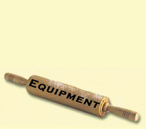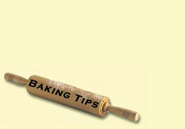| |

As far as we
know, breadmaking started almost as far back in history as man goes.
It is believed to have been discovered by someone in the Middle
East some 5000 or more years before Christ. Wheat was grown in this
area as a grass. No one know who made the first loaf but it has
been speculated that a poor breadmaker left his flour mixed with
water too long as he or she went to take care of a different problem.
When that person came back, yeast had done its trick of raising
the bread. Being too poor to throw it out, they baked it and voila!
Egyptians usually get credit for inventing the oven and discovering
leavening. Bread was offered to their Gods. You can see pictures
of their breads in Pharaohs' tombs. According to historians, bread
was used as money. Egyptians paid their slaves who built their historic
pyramids 3 loaves of bread and 2 jugs of beer a day for each worker.
During the excavation of the ancient city of Ur of the Chaldeas,
archaeologists discovered-and lighted-ovens used for bread baking
some 3,900 years before.
The Greeks refined the milling of flour and baking methods. The
Romans learned from them and improved the cultivation of wheat,
developing new varieties.
Baker's Guild
A
college of bakers was formed shortly after Christ's death (the beginnings
of the Baker's Guild). Through the centuries strict laws were imposed
on bakers regarding the "social classes of bread" - senator's
bread, nobles' bread, knights' bread, people's bread, peasants'
bread, the bread varing from white to coarse dark, depending on
the category. The quality and weight of each loaf were also supervised.
The baker milled his own flour until the Middle Ages, when the specialized
miller moved near the streams to utilize the water power for his
mills, and the baker remained close to his customers.
Bakers all over the world have an unwritten law, which was once
an oath, to bake enough each day. The baker's dozen originated in
the Middle Ages when the bakers,\ who didn't abide by the oath,
or short-weighed the bread, were beheaded in England and dunked
in public in the Germanic provinces: hence the adding of one extra
to the dozen!
American
Breads
Friendly Indians
showed colonists how to grow corn and how to prepare it for food.
Pioneer women improved on the cooking techniques, adding flour to
the corn. When people traveled, they went on foot or horseback,
sleeping and eating in the forest. They carried corn bread for sustenance.
That's why it was called journeycake.
When rough roads and taverns were built and stagecoaches carried
passengers, journeycake somehow became johnnycake, a name may easterners
still use for corn breads. There are many kinds of cornbreads in
American and each region has it specialties.
Sour dough breads are considered to have come from the American
Old West . There are many stories about a crock of sour dough starter
being left near the fire to warm and bubble. "Sourdough"
was the name attached to Alaskan prospectors or Canadian foresters
because these pioneers carried the wild yeast, sour dough, with
them in a lump for making bread while camping. During the Gold Rush
days, according to legend, the prospectors treasured their sourdough
starter like gold nuggets. They carried it with them from camp to
camp, sometimes nestled in the top of a bag of flour, so they could
have fresh sourdough biscuits every day.
The starter, part of which was saved from one baking to the next,
usually leavened sour dough biscuits and pancakes and gave them
the characteristic tangy flavor. Sour dough is kept in a closed
jar or crock and contains a living, continuous fermentation. After
the Starter has reached the desired "sourness", keep it
in the refrigerator. Bring the amount required for a recipe up to
room temperature before making bread. If it is not used frequently,
starter has to be "fed " a cup of flour or a tablespoon
of sugar a week, add water as needed to keep the starter from becoming
too thick.
The Magic
Protein
The magic
in flour is gluten, a protein. Bread bakers in the ancient world
used "barm," the thick scum on top of fermenting wine,
for leavening. Sometime along history's path, women began to make
their own yeast from hops. However, the strength of this home-made
product varied. In our grandmother's day, cakes of dry yeast, containing
a few slow-growing yeast plants, were used. To give the yeast time
to grow, bread bakers set a sponge of water, flour and the crumbled
yeast cake, and let it stand overnight in a warm place. By morning,
the yeast plants had multiplied enough that it could be used.
During WWII, research workers discovered how to remove water from
moist yeast. Active dry yeast was the result. This active dry yeast
had remarkable keeping qualities, providing it was stored in airtight
packages. You can proof the yeast (to see if it is still alive after
sitting in the refrigerator for months) by putting it in about 1/4
cup warm water (about 80F degrees) with a little sugar and letting
it sit for 15 minutes. If it becomes bubbly on top, it can be used.
|







